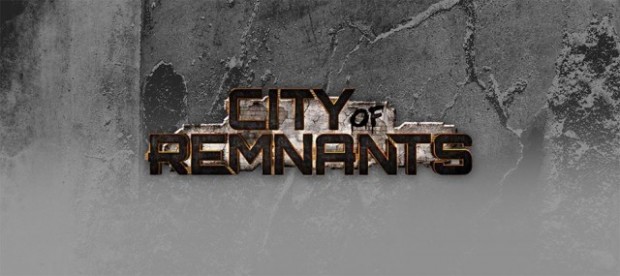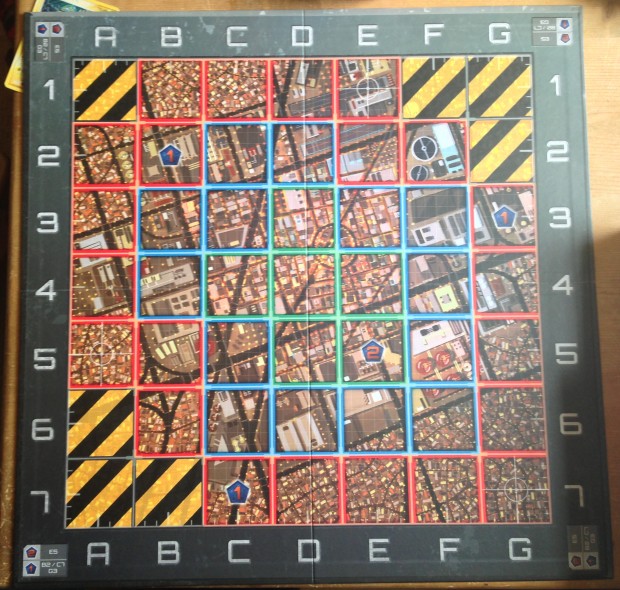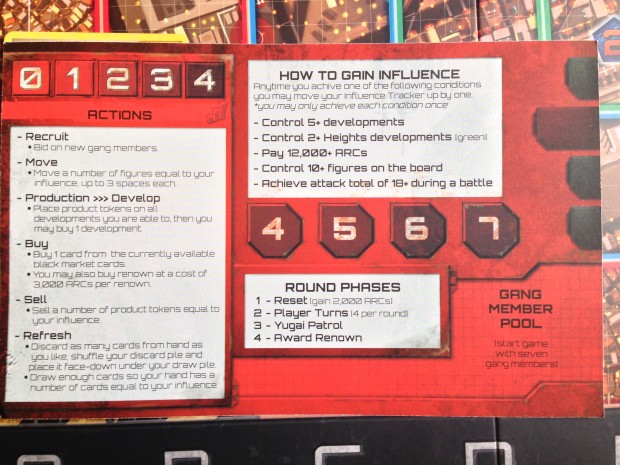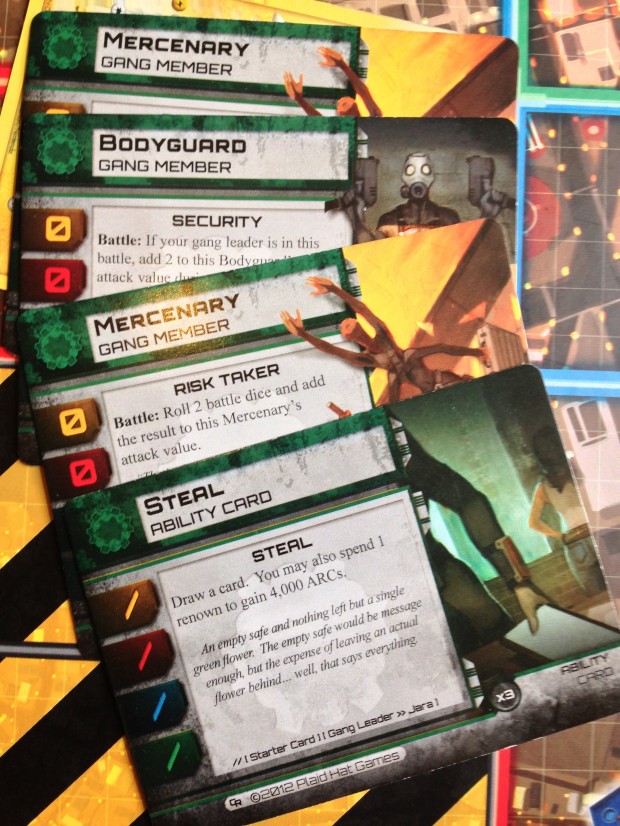Friday Night Unplugged #21.1: City of Remnants
- Updated: 24th May, 2013
Welcome to another week of Friday Night Unplugged. We’re preparing for what looks to be an epic month with a two-part focus on Plaid Hat Games’ latest release City of Remnants. All this is in preparation for when we get hands on with the sprawling Game of Thrones Second Edition in what will probably be one of the biggest features we’ve had so far on FNU.
What is it?
City of Remnants is a 2-4 player territory control game set in the grimy underbelly of a futuristic refugee city. Each player takes on the role of one of four rival gangs, each trying to prove themselves victorious. Managing developments, troops and cash flow is of vital importance. CoR comes with a horde of player mats, tokens and gang member figures.
The Basics:
Play is set on a 7×7 square square of city where players will move gang members, build new developments and manage those developments to produce more resources. At the end of each round, renown tokens are handed out based on the current board state. The game ends when there are no renown tokens left, with whoever has the most renown winning the game. Players control a space by being the only player with one of their gang members on it.
The game starts with each player having seven gang member figures in their pool, a deck made from their gang color pile and 2000 ARCs in their pool (ARCs being the currency in CoR). A selection of Developments are arranged at one end of the play area along with new gang member cards set out for bidding and items from the Black Market available for purchase.
The core of CoR revolves around gang member cards and developments. I’ll go into more details on the developments later but the gang member cards are used for both combat and gaining bonuses or other effects through the game. They make the core of a player’s deck.
During player turns, each player has a choice of six actions they can take. They can take each action only once and can perform a maximum of four actions. Play circles around the players with each player taking one of their actions one at a time. The actions are as follows:
- Recruit : Players can start a bid on the chosen gang member card from the displayed cards. Each player gets to bid an increasing number of ARCs until only one player is still willing to make a higher offer. If you’re the player who chose to recruit you are guaranteed to gain at least one new card and a gang member in your pool, thanks to some more complex but well balanced rules.
- Move: The move action allows you to move a number of figures up to your Influence total (this starts at 4) around the board with each moving up to three spaces.
- Production > Development: This action is at the core of the economic machine essential to advance in CoR. Any spaces you control on may have the ability to create product tokens. This action places the set number of Product tokens on any available spaces then follows up with you being able to buy a new development (more on these later).
- Sell: Selling goes hand in hand with Production>Development and It allows you to sell product tokens from developments you control up to your Influence total for a number of ARCs listed on the respective developments you sold tokens from.
- Buy: The buy action allows you to purchase any displayed Black Market card for its ARC value or buy renown for 3000 ARCs per renown.
- Refresh: This allows you to discard cards from your hand, shuffle your discard pile then draw new cards up to your hand limit.
Combat is simple. Players with gang members sharing spaces play any number of cards from their hand for their power value then roll battle dice equal to the number of gang members on and adjacent to the contested square. Whoever has the highest battle score wins that round. Their opponent removes one gang member from the square and puts it back into his pool, then removes one of the played cards from the game. Combat continues until the space is no longer contested.
Lastly a little more detail on Developments. The city board, as pictured above, is split into 3 coloured zones. The red outer zone represents the slums; the blue, the mid-town; and the green, the high-town. Each zone costs more to develop but also yields greater amounts of Product and a greater ARC income to match. Players gain renown at the end of the round from item cards and Developments they control.
In summary, the idea is to build developments, use those developments to create a supply chain and use the ARC’s to buy new gang members. As your gang’s numbers increase you can start to expand and even challenge your opponents. Of course there’s only so much you can understand without seeing it in action but we’ll be bringing you a full playthrough of City of Remnants next week so be sure to check back then.
What do we think?
Imagine Smallworld or Risk, mixed with Agricola with a blending of Shadowrun thrown in and you’ll get close to the feel City of Remnants invokes. It’s a rather wonderful mix and a far cry from the fantasy stylings of Mice and Mystics. The tight board space forces players to fight for the best spots and having limited actions per round pushes you into making tough choices. Should you make some new product and create a new development, can you move your gang there in time to claim it? Or should you just start moving into your opponent’s developments and attempt to take them for yourself?
It isn’t without its problems though, as it suffers from what I like to call FFG syndrome. Named after the premier boardgame publisher Fantasy Flight Games, FFG syndrome is more of a side-effect than a problem. Like Fantasy Flight’s games, City of Remnants has a ton going on for new players to get used to. Turn orders, influence, developments, product, gang members and the black market to name but a few each with their own rule system and complexities to remember. Luckily, Plaid Hat Games have released a handy tutorial making the whole process simpler.
City of Remnants not only stands spectacularly on its own it also gives me high hopes for the future. Designed by Isaac Vega, CoR is a sign of things to come as Vega is also the mastermind behind the upcoming Bioshock Infinite: Siege for Columbia boardgame that looks to take the economic and tactical mastery of CoR and throw it into a world of handymen and transport rails.
Next Week: City of Remnants Part 2: The Playthrough
Come back next week as myself, Fi and Josh duke it out on the streets and see who comes up victorious in the battle for control. Plus our final thoughts and recommendations on whether you should pick up City of Remnants.





Follow Us!